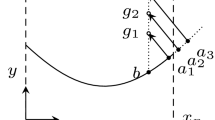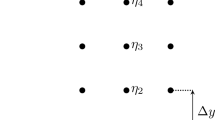Abstract
Boundary condition is one of the major factors to influence the numerical stability and solution accuracy in numerical analysis. One of the most important physical boundary conditions in the flowfield analysis is the wall boundary condition imposed on the body surface. To solve a two-dimensional Euler equation, totally four numerical wall boundary conditions should be prescribed. Two of them are supplied by the flow tangency condition. The other two conditions, therefore, should be prepared additionally in a suitable way. In this paper, four different sets of wall boundary conditions are proposed and then applied to solve high-speed flowfields around a quarter circle geometry. A two-dimensional compressible Euler solver is prepared based on the finite volume method. This solver hires three different upwind schemes; Steger-Warming’s flux vector splitting, Roe’s flux difference splitting, and Liou’s advection upstream splitting method. It is found that the way to specify the additional numerical wall boundary conditions strongly affects the overall stability and accuracy of the upwind schemes in high-speed flow calculation. The optimal wall boundary conditions should be also chosen very carefully depending on the numerical schemes used to solve the problem.
Similar content being viewed by others
Abbreviations
- a :
-
Speed of sound
- E :
-
Total energy per unit mass
- F :
-
directional convection term
- G :
-
directional convection term
- H :
-
Total enthalpy per unit mass
- M :
-
Mach number
- P :
-
Pressure
- Q :
-
Conservative variables
- S :
-
Eigenvector matrix
- u :
-
x-directional velocity component
- ν:
-
y-directional velocity component
- α:
-
Angle of attack
- γ:
-
Specific heat ratio
- Λ:
-
Eigenvalue matrix
- λ:
-
Eigenvalue
- ϱ:
-
Air density
- (·) R :
-
Variable quantity at node point (i+1)
- (·) L :
-
Variable quantity at node point (i)
References
Chakravarthy, S.R., Anderson, D. A., and Salas, M. D., 1980, “The Split-Coefficient Matrix Method for Hyperbolic Systems of Gas Dynamic Equations,” AIAA Paper 80-0268.
Cho, Ji Ryong, 1997, “A Convection Scheme Sensitized to the Convection Direction of a Scalar Quantity,”KSME International Journal, Vol. 11, No. 1, pp. 106–114.
Harten, A., 1983, “High Resolution Schemes for Hyperbolic Conservation Laws,”Journal of Computational Physics, Vol. 49, pp. 357–393.
Kim, K.H., Lee, J.H., and Rho, O.H., 1998, “An Improvement of AUSM Schemes by Introducing the Pressure-Based Weight Functions,”Computer & Fluids, Vol. 27, No. 3, pp. 311–346.
Kim, M.S., 2000, “A Comparative Study of Different Upwind Schemes in Inviscid Transonic and Supersonic Flowfields,”Journal of the Korean Society for Aeronautical and Space Sciences, Vol. 28, No. 2, pp. 26–34.
Kim, M.S. and Kim, H.K., 2000, “An Investigation of Characteristics of Roe’s FDS by Using the Compressible Euler Equations,”Journal of the Korean Society for Aeronautical and Space Sciences, Vol. 28, No. 7, pp. 1–9.
Liou, M.S., 1996, “A Sequel to AUSM: AUSM+,”Journal of Computational Physics, Vol. 129, pp. 364 -382.
Liou, M.S. and Steffen Jr. C.J., 1993, “A New Flux Splitting Scheme,”Journal of Computational Physics, Vol. 107, pp. 23–39.
Liou, M.S. and Wada, Y., 1994, “A Flux Splitting Scheme with High-Resolution and Robustness for Discontinuities,” AIAA Paper 94-0083.
Moretti, G., 1979, “The γ-Scheme,”Computer and Fluids, Vol. 7, pp. 191–205.
Roe, P.L., 1981, “Approximate Riemann Solvers, Parameter Vectors and Difference Schemes,”Journal of Computational Physics, Vol. 43, pp. 357–372.
Steger, J.L. and Warming, R.F., 1981, “Flux Vector Splitting of the Inviscid Gasdynamics Equations with Application to Finite Difference Methods,”Journal of Computational Physics, Vol. 40, pp. 263–293.
Author information
Authors and Affiliations
Corresponding author
Additional information
First Author
Rights and permissions
About this article
Cite this article
Kim, MS., Jeon, BW., Kim, YN. et al. An implementation of the robust inviscid wall boundary condition in high-speed flow calculations. KSME International Journal 15, 671–680 (2001). https://doi.org/10.1007/BF03184384
Received:
Revised:
Issue Date:
DOI: https://doi.org/10.1007/BF03184384




